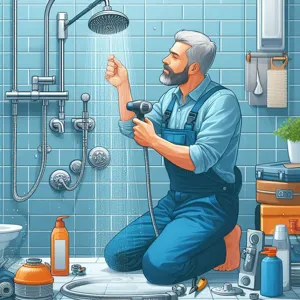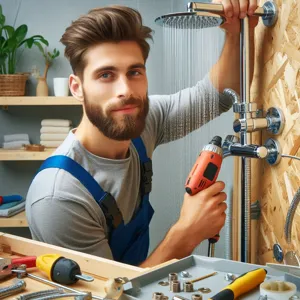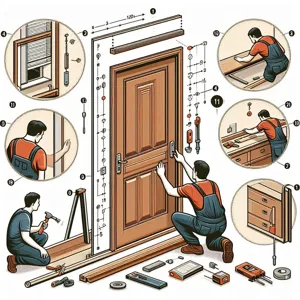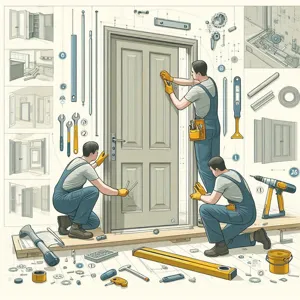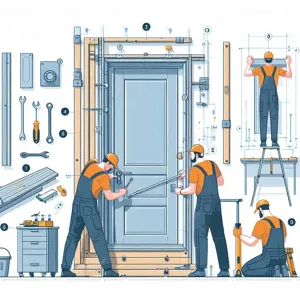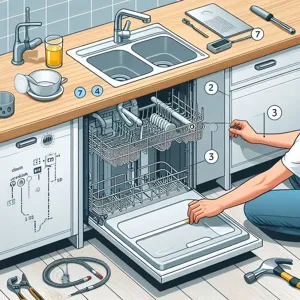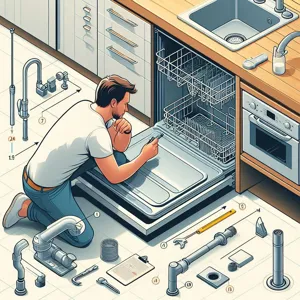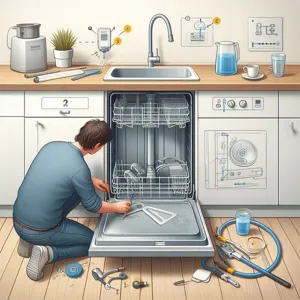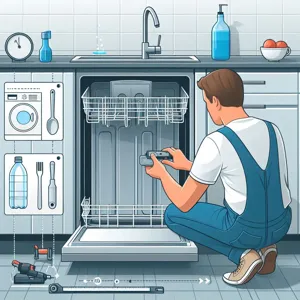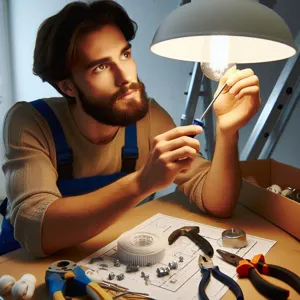Upgrading your kitchen or bathroom faucet can breathe new life into your space, making it not only more functional but also more stylish.
However, the thought of tackling a DIY plumbing project might seem daunting, especially if you’ve never attempted anything beyond a simple light bulb change. Fear not! With the right tools and a little guidance, you can install your new faucet like a seasoned professional. In this comprehensive, step-by-step guide, we’ll walk you through the entire process, from selecting the perfect faucet to ensuring a leak-free finish. Whether you’re a seasoned DIY enthusiast or a complete novice, our easy-to-follow instructions will empower you to take on this project with confidence. So roll up your sleeves and prepare to transform your sink area with a stunning new fixture that reflects your personal style and enhances your home!
1. Introduction: Why Install Your Own Faucet?

Installing your own faucet might seem like a daunting task reserved for seasoned DIYers, but with the right guidance, it can be a straightforward and rewarding project. Choosing to tackle this task on your own not only saves you money on plumbing costs, but it also gives you a sense of accomplishment and control over your home improvement efforts. Whether you’re looking to upgrade to a more modern style, replace a leaky unit, or simply refresh your kitchen or bathroom’s look, installing a new faucet can dramatically enhance both functionality and aesthetics.
Moreover, understanding the ins and outs of your plumbing fixtures empowers you to make informed decisions in the future. You’ll learn about your water supply lines, how to identify potential issues, and when it’s time to call in a professional. Plus, there’s something incredibly satisfying about stepping back and admiring a job well done, knowing that you’ve not only improved your space but also added a personal touch to your home.
In this step-by-step guide, we’ll break down the process of faucet installation into manageable parts, ensuring that you have the confidence and knowledge to complete the job like a pro. So, roll up your sleeves, gather your tools, and let’s get started on transforming your sink area into a stylish and functional space!
2. Tools and Materials You’ll Need
Before diving into the installation process, it’s essential to gather all the necessary tools and materials to ensure a smooth and efficient experience. Having everything on hand will save you time and frustration, allowing you to focus on achieving that professional finish.
**Tools:**
1. **Adjustable Wrench:** This versatile tool is perfect for loosening and tightening nuts and bolts on your faucet.
2. **Basin Wrench:** A must-have for reaching those hard-to-access nuts under your sink, the basin wrench provides the leverage you’ll need to secure fittings without straining your hands.
3. **Screwdriver Set:** Both flathead and Phillips screwdrivers are essential for securing mounting screws and making any necessary adjustments.
4. **Plumber’s Putty or Silicone Sealant:** Use this to create a watertight seal around the base of your new faucet, preventing leaks and ensuring longevity.
5. **Pipe Wrench:** If you encounter stubborn pipes, a pipe wrench will give you the grip and torque needed to turn them without damaging the fittings.
**Materials:**
1. **New Faucet:** Choose a faucet that fits your sink’s configuration and matches your style preferences. Read reviews and product details to ensure quality.
2. **Supply Lines:** These flexible hoses connect your faucet to the water supply. Ensure they are compatible with your faucet and sink.
3. **Tephlon Tape:** This handy tape is used to wrap threaded connections, ensuring a tight seal that helps prevent leaks.
4. **Cleaning Supplies:** Before installation, make sure you have some cloths or sponges to clean your workspace and remove any old putty or debris from your sink.
5. **Bucket or Towels:** It’s always a good idea to have a bucket or some towels nearby to catch any excess water that may spill during the installation process.
With your tools and materials assembled, you’re now ready to tackle the installation of your new faucet. This preparation will not only streamline the process but also instill confidence as you work towards achieving that pro-like result!
3. Choosing the Right Faucet for Your Space

Choosing the right faucet for your space is a crucial step that can significantly impact both the functionality and aesthetic of your kitchen or bathroom. With a myriad of styles, finishes, and functionalities available, selecting the perfect faucet can feel overwhelming. However, taking a moment to consider your space’s unique needs can make the decision-making process smoother and more enjoyable.
first, assess the overall style of your room. Are you aiming for a modern, sleek look with clean lines and polished chrome, or do you prefer a rustic vibe with a vintage-inspired design and matte bronze finish? Consider the existing fixtures and decor as well; your new faucet should complement and enhance the overall theme rather than clash with it.
Next, think about the functionality you need. Do you frequently cook and require a high-arc faucet that offers ample clearance for filling pots and pans? Or perhaps you need a pull-down sprayer for easy rinsing and washing? Identify the features that will best serve your daily tasks, such as single or dual handles, touchless technology, or water-saving options.
Also, don’t forget about the size and configuration of your sink. A large, farmhouse-style sink may benefit from a more substantial faucet that can hold its own against the expansive basin, while a smaller, undermount sink may call for a more streamlined option. Ensure that the faucet’s spout height and reach are appropriate for your sink’s dimensions to avoid any splashing or inconvenience.
Finally, consider the installation requirements. Some faucets come with complex mounting systems or require additional tools, while others are designed for easy DIY installation. If you’re not comfortable with plumbing tasks, it might be wise to choose a model that is straightforward to install or to consult with a professional.
By taking the time to thoughtfully choose a faucet that aligns with your space’s style, functionality, and installation needs, you’ll not only enhance the visual appeal of your kitchen or bathroom but also ensure a seamless and enjoyable experience for years to come.
4. Preparing Your Workspace
Before diving into the installation process, it’s crucial to prepare your workspace properly. A well-organized and clean area not only enhances your efficiency but also minimizes the risk of accidents or misplacing essential tools. Start by clearing the space beneath your sink and removing any items that may obstruct your work. This will give you ample room to maneuver and access all necessary parts during the installation.
Next, ensure that the plumbing area is dry and free from any leaks. If you notice any drips or moisture, take a moment to fix these issues before proceeding. It’s also wise to have a towel or sponge handy to wipe up any spills that may occur during the process.
Gather all the tools you’ll need for the job. Typically, this includes a basin wrench, adjustable pliers, a screwdriver, plumber’s tape, and possibly a bucket to catch any excess water. Having everything at arm’s reach will save you valuable time and prevent frustration.
Finally, don’t forget to turn off the water supply to the sink. Locate the shut-off valves under the sink and twist them clockwise to prevent any unexpected gushes while you’re working. By taking these preparatory steps, you’ll set yourself up for a smoother installation experience, allowing you to focus on the task at hand and achieve professional-level results!
5. Shutting Off the Water Supply
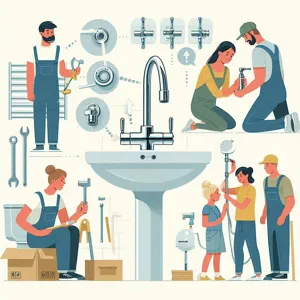
Before you dive into the world of plumbing and start removing your old faucet, it’s crucial to shut off the water supply. This step is often overlooked by novice DIYers, but it’s essential for preventing a mini waterfall in your kitchen or bathroom.
Locate the shut-off valves under your sink. These valves are typically positioned on the wall behind the sink or on the pipes leading to the faucet. You should see two valves—one for the hot water and one for the cold. To turn them off, simply twist the handles clockwise until they stop. If your sink doesn’t have individual shut-off valves, you may need to turn off the main water supply for your home. This can usually be found in your basement or near the perimeter of your home, often close to the water meter.
Once you’ve shut off the water supply, it’s a good idea to open the faucet to relieve any remaining pressure in the pipes. This will also help to drain any water left in the lines, making the installation process a lot cleaner and easier. Keep a towel handy, just in case there are any drips!
By ensuring that the water supply is completely turned off, you can proceed with confidence, knowing that you’ve taken the necessary precautions to avoid any mishaps. With this crucial step completed, you’re now ready to tackle the next phase of your faucet installation like a pro!
6. Removing the Old Faucet: A Step-by-Step Process
Removing the old faucet may seem daunting at first, but with a bit of patience and the right tools, you can tackle this task like a pro. Here’s a step-by-step process to make it as smooth as possible.
**Step 1: Gather Your Tools**
Before diving into the removal process, it’s essential to have the right tools on hand. You’ll need an adjustable wrench, a basin wrench (for those hard-to-reach spots), a screwdriver, a bucket to catch any water, and a cloth for any spills. Having everything ready will save you time and frustration.
**Step 2: Turn Off the Water Supply**
Locate the shutoff valves under your sink and turn them clockwise to stop the water flow. If you can’t find these valves, it may be necessary to shut off the main water supply for your home. Don’t forget to turn on the faucet to release any remaining pressure and drain the water from the lines.
**Step 3: Disconnect the Water Supply Lines**
Place your bucket underneath the sink to catch any water that may drip during the process. Using your adjustable wrench, carefully loosen the nuts that connect the water supply lines to the faucet. Once loosened, gently pull the lines away from the faucet and lay them aside.
**Step 4: Remove the Faucet Mounting Nuts**
Now it’s time to tackle the mounting nuts that secure the faucet to the sink. These may be located underneath the sink and can be tricky to reach. Use your basin wrench to grip and turn the nuts counterclockwise until they’re completely removed. If they’re particularly stubborn, a few drops of penetrating oil can help loosen them.
**Step 5: Take Out the Old Faucet**
With the mounting nuts removed, you should now be able to lift the old faucet out from the top of the sink. If it’s stuck, gently wiggle it back and forth to dislodge any remaining sealant or grime. Once freed, lift it out carefully and set it aside.
**Step 6: Clean the Sink Surface**
Before you install your new faucet, take a moment to clean the area where the old faucet was mounted. Remove any old putty, debris, or mineral buildup with a scrub brush and a suitable cleaner. This will ensure a tight seal for your new installation.
By following these steps, you’ll have successfully removed your old faucet, making way for a fresh and stylish upgrade. With a little effort, you’re one step closer to enjoying your new faucet and enhancing the heart of your home!
7. Cleaning the Sink Area and Preparing for Installation

Before diving into the installation of your new faucet, it’s essential to ensure that the sink area is clean and free of any debris. A tidy work environment not only makes the process smoother but also prevents any potential mishaps during installation. Start by removing any items from the countertop and clearing the area beneath the sink; this will give you ample space to work without obstruction.
Next, use a sponge or cloth along with a mild cleaner to wipe down the sink basin and surrounding countertops. Pay close attention to any buildup or residue, particularly around the existing faucet and sinkholes. A clean surface will allow for a better seal and help prevent any leaks once your new faucet is installed.
Additionally, check the plumbing connections and surrounding areas for any signs of corrosion or damage. If you notice anything amiss, it’s wise to address these issues before moving forward with the installation. This step not only ensures a better fit for your new faucet but also prolongs its lifespan.
Finally, gather all your tools and installation materials, including the new faucet, mounting hardware, and any additional supplies you might need. By organizing everything in advance, you’ll save time and keep your workspace efficient. With the sink area cleaned and prepped, you’re now ready to tackle the installation process like a pro!
8. Installing the New Faucet: A Detailed Guide
Installing a new faucet may seem like a daunting task, but with the right guidance, you can complete the job like a seasoned professional. This detailed guide will walk you through each step of the installation process, ensuring you achieve a seamless and efficient setup.
**Step 1: Gather Your Tools and Materials**
Before diving into the installation, it’s essential to have all the necessary tools and materials at your fingertips. You’ll need a basin wrench, adjustable wrench, plumber’s tape, a bucket to catch any excess water, and, of course, your new faucet. Having everything organized will save you time and frustration.
**Step 2: Shut Off the Water Supply**
The first critical step in any plumbing project is to turn off the water supply. Locate the shut-off valves under your sink and turn them clockwise until they are completely closed. If you can’t find them, you may need to shut off the main water supply for your home. Once the water is off, turn on the old faucet to drain any remaining water in the pipes.
**Step 3: Remove the Old Faucet**
Next, it’s time to detach the old faucet. Use your basin wrench to loosen and remove the nuts securing the faucet to the sink. Carefully disconnect the water supply lines, taking care to place a bucket underneath to catch any remaining water. If your old faucet is particularly stubborn, a bit of penetrating oil can help ease the removal process.
**Step 4: Prepare the Sink**
With the old faucet removed, take a moment to clean the sink surface thoroughly. Remove any old putty or debris that may interfere with the new installation. If your new faucet requires a gasket or mounting hardware, ensure these components are ready and in good condition.
**Step 5: Install the New Faucet**
Now comes the exciting part—installing your new faucet! Follow the manufacturer’s instructions closely. Typically, you’ll start by placing the faucet into the mounting holes of the sink. Secure it in place with the provided mounting nuts, tightening them with your adjustable wrench. Be careful not to overtighten, as this can damage the sink.
**Step 6: Connect the Water Supply Lines**
With the faucet securely in place, it’s time to connect the water supply lines. Attach the hot and cold water lines to the corresponding connections on the faucet, using plumber’s tape to ensure a tight seal. Make sure to connect them correctly—hot to hot and cold to cold—to avoid any mix-ups.
**Step 7: Turn on the Water Supply**
Once everything is connected, it’s time to turn the water supply back on. Go back to the shut-off valves and turn them counterclockwise to restore water flow. As you do this, check for any leaks around the connections. If you notice any, tighten the connections gently until the leak stops.
**Step 8: Test Your New Faucet**
With everything in place, turn on your new faucet to test its operation. Allow the water to run for a minute to clear any air bubbles and sediment. Check for leaks again during this process. If everything looks good, congratulations! You’ve successfully installed your new faucet.
By following these steps, you can transform your kitchen or bathroom with a new faucet without the need for professional help. Enjoy the satisfaction of your handiwork and the enhanced functionality of your space!
9. Connecting the Water Supply Lines
Connecting the water supply lines is a crucial step in the faucet installation process, and it’s one that can make or break your entire project. With the faucet securely mounted and all the necessary tools within reach, it’s time to turn your attention to those water supply lines—the veins that will bring life to your new fixture.
Start by ensuring that the water supply valves beneath your sink are turned off. This is essential to prevent any sudden sprays or floods when you begin working. Once you’ve confirmed the valves are closed, it’s a good idea to place a bucket or a towel under the sink to catch any residual water that may spill out during the connection process.
Next, locate the supply lines that will connect to your faucet. Most faucets require both hot and cold water lines, which will be clearly marked. If your new faucet didn’t come with supply lines, you can purchase flexible stainless steel or braided nylon lines that are designed to withstand high pressure and resist corrosion.
Carefully thread the supply line nuts onto the corresponding faucet inlets, ensuring that you match the hot line to the hot inlet and the cold line to the cold inlet. When tightening the connections, use a wrench, but be cautious not to overtighten—this can lead to stripped threads or cracked fittings. A snug fit is all you need; think of it like a firm handshake—strong but not overbearingly tight.
Once the connections are secure, it’s time to turn the water supply back on. Do so slowly, allowing the lines to fill with water gradually. As the pressure builds, keep an eye on the newly connected lines for any signs of leaks. If you spot any drips, it may be necessary to tighten the connections slightly more or check the washers and seals to ensure they’re properly seated.
With the water supply lines securely connected and leak-free, you’re one step closer to enjoying your new faucet. Take a moment to admire your handiwork; you’re well on your way to completing a professional-quality installation right in your own home!
10. Sealing and Securing the Faucet
Once your new faucet is in place, the final step—sealing and securing it—ensures that it operates smoothly and prevents any leaks. This crucial phase not only guarantees that your installation is watertight but also enhances the longevity and performance of your faucet.
Start by applying a bead of plumber’s putty or silicone sealant around the base of the faucet where it meets the sink. This step is essential for creating a reliable seal that will keep water from seeping underneath the faucet and causing damage over time. If you’re using plumber’s putty, roll it into a rope-like shape and lay it down evenly. If you prefer silicone, apply a neat line around the edge, ensuring it’s not too thick, as excess sealant can be squeezed out when the faucet is pressed down.
Next, carefully lower the faucet into position, aligning it with the mounting holes. Once it’s seated correctly, secure it from underneath the sink using the mounting nuts provided with your faucet. Tighten these nuts by hand, and then use a wrench for a snug fit—just be cautious not to overtighten, as this could damage the sink or the faucet itself.
Finally, to add an extra layer of security, check the alignment of the faucet and adjust as necessary. Ensure that the handles are positioned correctly and that the spout is centered. After making any adjustments, give everything a final tightening, and wipe away any excess sealant that may have oozed out during installation.
With the faucet securely in place and properly sealed, you’re ready to reconnect the water supply. Turn on the valves slowly and check for any leaks around the connections. If you notice any, it may be an indication that you need to tighten the connections or reapply sealant. Once everything is secure and leak-free, take a moment to admire your handiwork—your new faucet is now ready to serve you in style!
11. Turning the Water Supply Back On
Once you’ve successfully installed your new faucet and double-checked all the connections, it’s time for one of the most crucial steps: turning the water supply back on. This moment is not just about restoring functionality to your sink; it’s the moment of truth that will determine if your installation was a success.
Before you proceed, ensure that you have towels or a sponge handy to catch any unexpected drips. Begin by locating the shut-off valves under your sink. These valves are typically situated on the wall or the floor, and they control the water flow to your faucet. With a gentle twist, turn the valves counterclockwise to open them.
As you do this, listen for the faint sound of water rushing back into the pipes. It’s an exhilarating moment, but don’t get too excited just yet! Once the valves are fully open, it’s time to check for leaks. Turn on your new faucet to its full flow and observe closely around the base and the connections you’ve just made. If you spot any drips or moisture, it may indicate that a connection wasn’t tightened properly or that a washer needs to be adjusted.
While the water is running, take a moment to check the temperature. Adjust the hot and cold levers to ensure that both are functioning smoothly and that the water temperature is to your liking. This step not only confirms that your installation was successful but also allows you to familiarize yourself with the faucet’s controls.
If all looks good—no leaks, and the water flows beautifully—you can take a deep breath and revel in your accomplishment. You’ve just turned your kitchen or bathroom into a more functional space, all while developing your DIY skills! Don’t forget to clean up any residual water around the sink. Congratulations, you’ve officially crossed the finish line of your faucet installation project!
12. Testing for Leaks and Proper Functioning
Once you’ve successfully installed your new faucet, the moment of truth arrives: it’s time to test for leaks and ensure that everything is functioning as it should. This crucial step not only confirms that your hard work has paid off but also prevents future water damage and costly repairs.
Start by turning on the water supply valves beneath your sink. As you do this, keep a close eye on the connections you made during the installation process. Look for any signs of water seeping from the joints or under the sink. If you spot a leak, don’t panic! Tighten the connections gradually, but be careful not to overtighten, as this could cause damage.
Next, turn on the faucet and let the water run for a minute or so. Observe the flow; it should be steady and consistent. Move the handle through its full range of motion to ensure it operates smoothly. Pay attention to the temperature control as well—make sure that both hot and cold water are functioning correctly and that the temperature adjusts as expected.
While the water is running, check for any unusual noise or vibration that might indicate an issue with the installation. If everything sounds perfect, take a moment to inspect the area around the sink for any signs of dripping water or dampness.
Finally, don’t forget to test the sprayer, if your faucet has one. Activate it and check for proper operation and any leaks at the connection point.
By thoroughly testing your faucet, you can be confident that you’ve completed the installation like a pro. This attention to detail not only enhances your experience but ensures that your new fixture will serve you well for years to come.
13. Final Touches: Cleaning Up and Maintenance Tips
Once you’ve successfully installed your new faucet, it’s time to focus on the final touches that ensure everything looks pristine and operates smoothly. A clean work area not only enhances the aesthetic appeal of your newly installed faucet but also cements your accomplishment as a DIY champion!
**Cleaning Up:** Start by wiping down the surrounding area of the sink with a damp cloth to remove any dust, debris, or fingerprints that may have accumulated during the installation process. Pay special attention to the base of the faucet and the countertop—these spots can often be overlooked but are crucial for maintaining a polished look. If there are any water spots or mineral deposits, a gentle cleanser or a mixture of vinegar and water can work wonders. Just be sure to avoid abrasive cleaners that might scratch the surface.
**Check for Leaks:** Before you call it a day, turn on the faucet and let the water run for a minute. Keep an eye out for any leaks around the connections. If you notice any drips, double-check that the nuts and connections are tightened properly. It’s always better to address leaks now rather than waiting until they become a bigger problem later.
**Maintenance Tips:** Now that your faucet is installed and gleaming, regular maintenance will help keep it in top condition. Consider setting a reminder to clean the faucet every couple of weeks. Use a soft cloth and a mild soap solution to wipe it down, preventing buildup and keeping it shiny. For those pesky mineral deposits, a routine application of vinegar can help maintain the faucet’s finish.
Additionally, inspect the faucet aerator regularly. Over time, it can accumulate debris or mineral buildup that affects water flow. Unscrew it from the tip of the faucet, rinse it out, and clean it with a brush if necessary, ensuring optimal performance.
By taking these final steps to clean up and maintain your new faucet, you’ll not only enjoy its functionality but also extend its lifespan. A little care goes a long way, turning your installation success into a long-lasting triumph!
14. Troubleshooting Common Installation Issues
Even the most skilled DIYers can encounter challenges during a faucet installation, so it’s essential to be prepared for potential hiccups along the way. Here are some common issues you might face and how to troubleshoot them effectively:
**1. Leaky Connections:** One of the most frequent problems after installation is a leak at the connections. If you find water dripping from the faucet or underneath the sink, start by checking the tightness of the connections. Use an adjustable wrench to ensure that the nuts are snug but not overtightened, which can cause damage. If the leak persists, inspect the rubber washers or O-rings; they may need replacing or may not have been seated correctly.
**2. Low Water Pressure:** If your new faucet isn’t delivering water at the expected pressure, first check the aerator. Mineral deposits can accumulate over time, restricting water flow. Remove the aerator and soak it in vinegar to dissolve any buildup. If cleaning doesn’t help, ensure that the shut-off valves under the sink are fully open and that there are no kinks in the water supply hoses.
**3. No Hot Water:** Sometimes, a newly installed faucet may only deliver cold water. This could be due to a few reasons: ensure that the hot water supply line is properly connected and that the shut-off valve for hot water is open. If everything looks good but you still have no hot water, the issue might stem from your water heater or plumbing system.
**4. Noisy Faucet:** If your faucet is making strange noises—like whistling or banging—when water flows, it could indicate air in the pipes or improper installation. Start by turning off the water supply and then open the faucet to release any trapped air. If the noise persists, check for loose fittings or vibrations in the supply lines that may need to be secured.
**5. Difficulty Turning the Faucet Handle:** If the handle feels stiff or is hard to turn, it could be due to improper installation or misalignment. Inspect all components to ensure they are properly seated and aligned according to the manufacturer’s instructions. Sometimes, a little lubrication on the handle mechanism can make a significant difference.
By keeping these troubleshooting tips in mind, you can tackle common installation issues with confidence. Remember, patience is key—take your time to identify and resolve any problems, and soon enough, you’ll have a perfectly functioning faucet that enhances your kitchen or bathroom beautifully!
15. Conclusion: Enjoying Your New Faucet!
Congratulations! You’ve successfully navigated the installation process and now it’s time to sit back and enjoy the fruits of your labor. A new faucet not only enhances the aesthetics of your kitchen or bathroom, but it also brings functionality and ease to your daily routine.
As you turn on the tap for the first time, listen to the gentle flow of water and feel the smoothness of the handle. Whether you’ve chosen a sleek modern design or a classic vintage style, your new fixture is sure to be a centerpiece in your space. Take a moment to appreciate the transformation you’ve achieved—imagine how much more enjoyable washing dishes or brushing your teeth will be with this upgraded feature.
Remember to keep an eye out for any leaks over the next few days and ensure that everything is functioning as it should. Familiarize yourself with any special features your faucet may have, such as touchless activation or temperature control, and enjoy the convenience they provide.
Lastly, don’t forget to maintain your faucet regularly to prolong its life and ensure it continues to perform flawlessly. A simple routine of cleaning and checking for wear and tear will keep your faucet looking great and functioning well for years to come.
Now, go ahead and celebrate your accomplishment! You’ve not only upgraded your home but also gained a valuable DIY skill. So raise a glass (or a mug) under your brand-new faucet, and toast to your success—here’s to many more projects in the future!
In conclusion, we hope this step-by-step guide has empowered you to tackle your faucet installation project with confidence and ease. With the right tools, a little patience, and the techniques outlined in this post, you can achieve professional-level results without the hefty price tag of hiring a plumber. Remember, each step is an opportunity to enhance not just your plumbing skills but also your home’s functionality and aesthetic appeal. So, roll up your sleeves, enjoy the process, and take pride in your accomplishment. Happy plumbing, and don’t hesitate to share your success stories or ask questions in the comments below!





